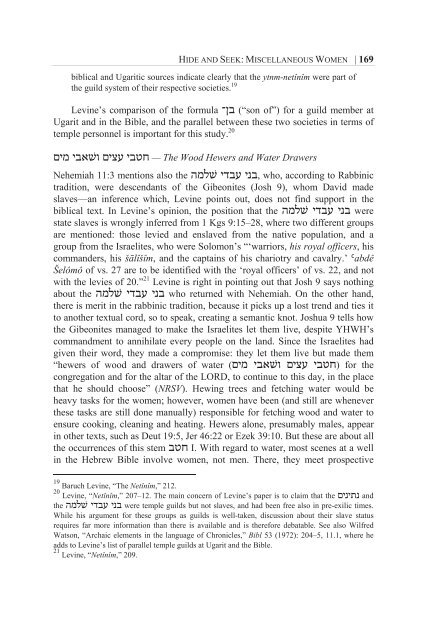Women at Work in the Deuteronomistic History - International Voices ...
Women at Work in the Deuteronomistic History - International Voices ...
Women at Work in the Deuteronomistic History - International Voices ...
Create successful ePaper yourself
Turn your PDF publications into a flip-book with our unique Google optimized e-Paper software.
HIDE AND SEEK: MISCELLANEOUS WOMEN | 169<br />
biblical and Ugaritic sources <strong>in</strong>dic<strong>at</strong>e clearly th<strong>at</strong> <strong>the</strong> ytnm-netînîm were part of<br />
<strong>the</strong> guild system of <strong>the</strong>ir respective societies. 19<br />
Lev<strong>in</strong>e’s comparison of <strong>the</strong> formula ־ןב (“son of”) for a guild member <strong>at</strong><br />
Ugarit and <strong>in</strong> <strong>the</strong> Bible, and <strong>the</strong> parallel between <strong>the</strong>se two societies <strong>in</strong> terms of<br />
temple personnel is important for this study. 20<br />
םימ יבאשׁו םיצע יבטח — The Wood Hewers and W<strong>at</strong>er Drawers<br />
Nehemiah 11:3 mentions also <strong>the</strong> המלשׁ ידבע ינב, who, accord<strong>in</strong>g to Rabb<strong>in</strong>ic<br />
tradition, were descendants of <strong>the</strong> Gibeonites (Josh 9), whom David made<br />
slaves—an <strong>in</strong>ference which, Lev<strong>in</strong>e po<strong>in</strong>ts out, does not f<strong>in</strong>d support <strong>in</strong> <strong>the</strong><br />
biblical text. In Lev<strong>in</strong>e’s op<strong>in</strong>ion, <strong>the</strong> position th<strong>at</strong> <strong>the</strong> המלשׁ ידבע ינב were<br />
st<strong>at</strong>e slaves is wrongly <strong>in</strong>ferred from 1 Kgs 9:15–28, where two different groups<br />
are mentioned: those levied and enslaved from <strong>the</strong> n<strong>at</strong>ive popul<strong>at</strong>ion, and a<br />
group from <strong>the</strong> Israelites, who were Solomon’s “‘warriors, his royal officers, his<br />
commanders, his šālîšîm, and <strong>the</strong> capta<strong>in</strong>s of his chariotry and cavalry.’ `abdê<br />
Šelômô of vs. 27 are to be identified with <strong>the</strong> ‘royal officers’ of vs. 22, and not<br />
with <strong>the</strong> levies of 20.” 21 Lev<strong>in</strong>e is right <strong>in</strong> po<strong>in</strong>t<strong>in</strong>g out th<strong>at</strong> Josh 9 says noth<strong>in</strong>g<br />
about <strong>the</strong> המלשׁ ידבע ינב who returned with Nehemiah. On <strong>the</strong> o<strong>the</strong>r hand,<br />
<strong>the</strong>re is merit <strong>in</strong> <strong>the</strong> rabb<strong>in</strong>ic tradition, because it picks up a lost trend and ties it<br />
to ano<strong>the</strong>r textual cord, so to speak, cre<strong>at</strong><strong>in</strong>g a semantic knot. Joshua 9 tells how<br />
<strong>the</strong> Gibeonites managed to make <strong>the</strong> Israelites let <strong>the</strong>m live, despite YHWH’s<br />
commandment to annihil<strong>at</strong>e every people on <strong>the</strong> land. S<strong>in</strong>ce <strong>the</strong> Israelites had<br />
given <strong>the</strong>ir word, <strong>the</strong>y made a compromise: <strong>the</strong>y let <strong>the</strong>m live but made <strong>the</strong>m<br />
“hewers of wood and drawers of w<strong>at</strong>er ( םימ יב אשׁו םיצע יבטח)<br />
for <strong>the</strong><br />
congreg<strong>at</strong>ion and for <strong>the</strong> altar of <strong>the</strong> LORD, to cont<strong>in</strong>ue to this day, <strong>in</strong> <strong>the</strong> place<br />
th<strong>at</strong> he should choose” (NRSV). Hew<strong>in</strong>g trees and fetch<strong>in</strong>g w<strong>at</strong>er would be<br />
heavy tasks for <strong>the</strong> women; however, women have been (and still are whenever<br />
<strong>the</strong>se tasks are still done manually) responsible for fetch<strong>in</strong>g wood and w<strong>at</strong>er to<br />
ensure cook<strong>in</strong>g, clean<strong>in</strong>g and he<strong>at</strong><strong>in</strong>g. Hewers alone, presumably males, appear<br />
<strong>in</strong> o<strong>the</strong>r texts, such as Deut 19:5, Jer 46:22 or Ezek 39:10. But <strong>the</strong>se are about all<br />
<strong>the</strong> occurrences of this stem בטח I. With regard to w<strong>at</strong>er, most scenes <strong>at</strong> a well<br />
<strong>in</strong> <strong>the</strong> Hebrew Bible <strong>in</strong>volve women, not men. There, <strong>the</strong>y meet prospective<br />
19 Baruch Lev<strong>in</strong>e, “The Netînîm,” 212.<br />
20 Lev<strong>in</strong>e, “Netînîm,” 207–12. The ma<strong>in</strong> concern of Lev<strong>in</strong>e’s paper is to claim th<strong>at</strong> <strong>the</strong> םיניתנ and<br />
<strong>the</strong> המלשׁ ידבע ינב were temple guilds but not slaves, and had been free also <strong>in</strong> pre-exilic times.<br />
While his argument for <strong>the</strong>se groups as guilds is well-taken, discussion about <strong>the</strong>ir slave st<strong>at</strong>us<br />
requires far more <strong>in</strong>form<strong>at</strong>ion than <strong>the</strong>re is available and is <strong>the</strong>refore deb<strong>at</strong>able. See also Wilfred<br />
W<strong>at</strong>son, “Archaic elements <strong>in</strong> <strong>the</strong> language of Chronicles,” Bibl 53 (1972): 204–5, 11.1, where he<br />
adds to Lev<strong>in</strong>e’s list of parallel temple guilds <strong>at</strong> Ugarit and <strong>the</strong> Bible.<br />
21 Lev<strong>in</strong>e, “Netînîm,” 209.




